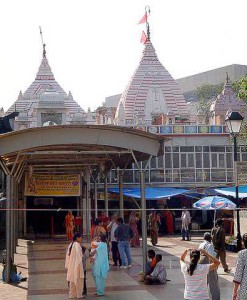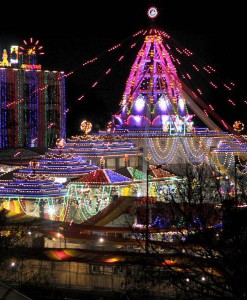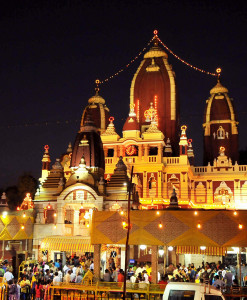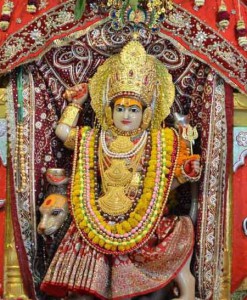No products in the cart.
Shri Digambar Jain Lal Mandir is the oldest and best-known Jain temple in Delhi, India. It is directly across from the Red Fort in the historical Chandni Chowk area.
It is known for an avian veterinary hospital in a second building behind the main temple. It is known as the Jain Birds Hospital.
Located just opposite the massive Red Fort at the intersection of Netaji Subhas Marg and Chandni Chowk, Digambar Jain Temple is the oldest Jain temple in the capital, originally built in 1656. An impressive red sandstone temple today (the temple has undergone many alterations and additions in the past and was enlarged in the early 19th century), Shri Digambar Jain Lal Mandir is popularly known as Lal Mandir “Red Temple”.
Shri Digambar Jain Lal Mandir, Delhi;
- Temple History
- Architecture
- How To Reach The Temple
- Daily Poojas And Festivals
- Videos
- Additional Information
Old Delhi was founded by Mughal Emperor Shah Jahan (1628–1658) who built what is commonly known as the old city or walled city, surrounded by a wall, with the main street Chandni Chowk in front of the Red Fort, the imperial residence.
Shah Jahan invited several Agrawal Jain merchants to come and settle in the city and granted them some land south of the Chandani Chauk around Dariba Gali. He also permitted them to build a temporary structure to house a Jain temple. The Agrawal Jain community acquired three marble idols installed by Jivaraj Papriwal under the supervision of Bhattaraka Jinachandra in Samvat 1548 (1491 AD) for the temple. The main icon is that of Tirthankara Parshva.
It is said that the deities in temple were originally kept in a tent belonging to an Agrawal Jain officer of the Mughal army.
During the Mughal period, the construction of a shikhara for a temple was not permitted. This temple did not have a formal shikhara until after India’s independence when the temple was extensively rebuilt.
In 1800-1807, Raja Harsukh Rai, the imperial treasurer obtained imperial permission to build a temple with a shikhara in the Agrawal Jain neighborhood of Dharamapura, just south of Chandani Chauk. Thus temple, known for fine carvings, is now known as the Naya Mandir “New Temple”.
The Gauri Shankar temple next to the Lal Mandir, was founded about a century later in 1761 by Appa Gangadhara, a Maratha Brahman in the service of the Scindia when Delhi was under their influence. It also has been significantly rebuilt in the past few decades.
A manastambha column stands in front of the temple. The main devotional area of the temple is on the first floor. It is reached by ascending to the terrace after crossing the small courtyard of the temple, surrounded by a colonnade. There are a number of shrines in this area but the main shrine is of Lord Mahavira, the 24th and last Tirthankara of the present Avasarpani era (half time cycle of decreasing happiness as per Jain cosmology). Born in 599 BC in the ancient republic of Vaishali (Bihar) as a prince, he renounced all worldly pleasures and comforts and went in search of ‘Moksha’ (salvation). Soon he attained Kevala Jnana (Enlightenment), and spent the rest of his life preaching to the people all over the country about the eternal truth of life and ways to attain Moksha. Though some believe that he was the founder of Jainism but he was in a real sense the reformer of an existing faith who reorganized and presented the tenets of the religion in a form suitable to the period.
The statue of Adinath, the first Tirthankara is also present here, along with the shrine of Lord Parshvanath, the immediate predecessor of Lord Mahavira. The temple is popular among the Jains. The place is very peaceful and the ambience is really soothing especially due to the shining of the gilded paintwork of the shrine area under the lights of butter lamps and candles.
In 1931, Acharya Shantisagar, a Digambara Jain monk arrived in Delhi. He was the first Digambara monk to visit Delhi after a gap of eight centuries. There is a memorial marking this historical occasion.
The temple compound has a famous Bird Hospital.[6]
The Birds Hospital, calls itself the only institution of its kind in the world, treats about 15,000 birds a year has been run for 60 years in the building built in 1957 under the instructions of Acharya Deshbhushan Maharaj, hospital itself was started in 1930.
By Road: The temple present in next to Digambar Jain Temple on the main Chandni Chowk road. Tourists can either take local buses from various points within the city to reach this sacred monument, or they can hire auto-rickshaws and taxis or metro rail.
By Rail: The nearest Railway Station to the temple is Old Delhi Railway Station
By Air: The Temple can be reached through nearest from Indira Gandhi International Airport which is well connected with regular domestic flights.
Visiting Hours:
Holi to Diwali (Summer Timing): 5:30 am to 11:30 am & 6:00 pm to 9:30 pm
Diwali to Holi (Winter Timing): 6:00 am to 12:00 pm & 5:30 pm to 9:00 pm

Tourists are welcome to visit the Sri Digambar Jain Lal Temple complex and enjoy the calm, soothing and peaceful ambience that adds to the old charm of the place. The temple premise also includes a bookshop containing a wide range of literatures on Jainism. Visitors must remove their shoes and other leather items and hand it over to the administrative personnel of the temple before entering. The temple also homes a Charity Hospital for Birds and offers free treatment. It also offers services to birds rescued from the accidents and bird hawkers. Squirrels and other small animals are also treated here as free of cost.
However, flesh eating birds like vultures, eagles and likewise are strictly treated only as an outpatient as they may cause a threat to the other birds and small animals living within the hospital premises









